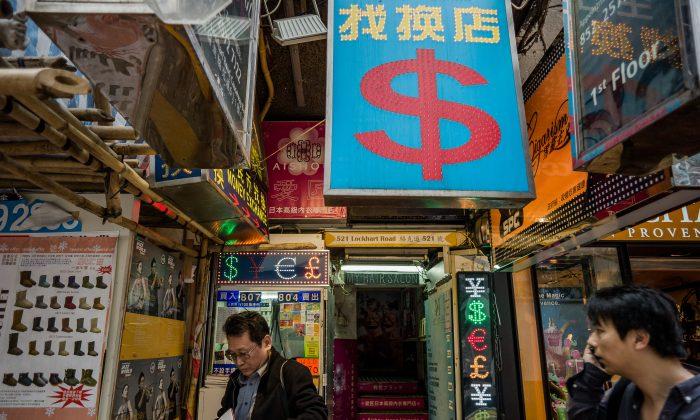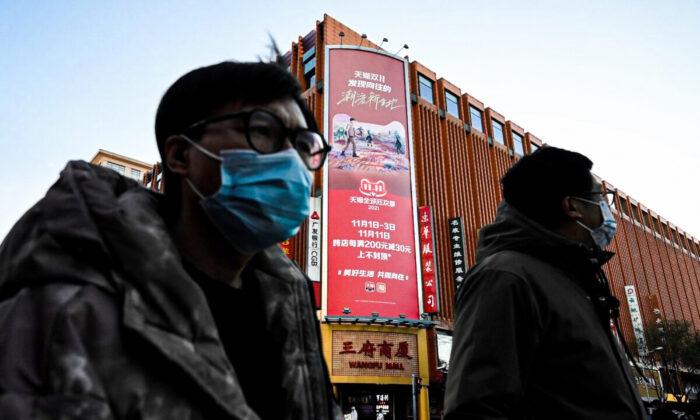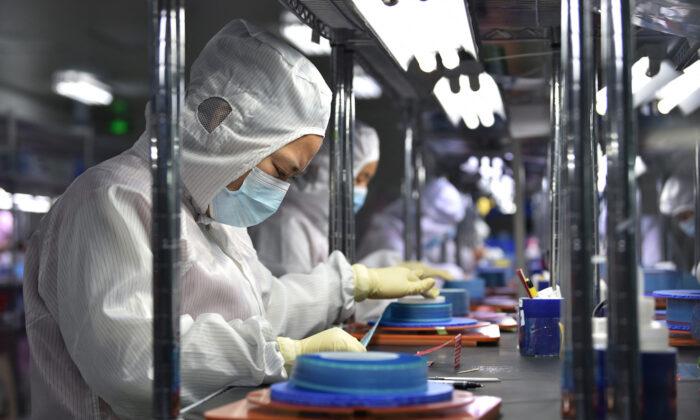Of late, Chinese media outlets are mentioning ever more frequently that other countries are staging a “currency war.” In articles claiming “China has become the victim of the Japanese yen devaluation” and the like, they argue that many countries raced to lower the value of their own currencies to maintain an edge in their own foreign trade and thus moved China’s cheese.
At the same time, these media outlets praise the Chinese government’s effort in maintaining the stability of the yuan. These articles made people inside the trade wonder why does Beijing not depreciate the Chinese currency to stimulate export like other countries did?
The reason behind this is not that Beijing is out of touch with the international market. The real reason is one that Beijing deemed unspeakable: The Chinese government now needs to rely on appreciation of the yuan to lure back fake foreign capital and thereby prevent the burst of the economic bubble.
Why are people skeptical about the growth in China’s foreign trade?
Before answering this question, let’s first look at incidents that took place in mid-February. China unveiled its foreign trade data, which claimed that the import-and-export trade industry was off to a good start in January 2014.
The released figure, however, raised general skepticism because two other sets of data related to China’s macro-economy did not support what the Chinese government claimed. This discrepancy reminded me of the unofficial “Li Keqiang index,” which takes into account the railway cargo volume, electricity consumption, and loans disbursed by banks.
When even the premier does not dare rely on the official data from the regime to gauge how the Chinese economy is doing, people who study the Chinese economy would, of course, have to learn how to analyze the official data.
When it comes to foreign trade data, China watchers have long used two other sets of data as cross reference.
The first set of data is the Manufacturing Purchasing Managers Index (PMI) and the New Export Orders Index and Import Index, which together reflect the foreign trade conditions of the manufacturing industry. In January, the PMI stood at 50.5, and the New Export Orders Index and Import Index were 49.3 percent and 48.2 percent respectively.
The second set of data includes the HSBC manufacturing PMI, which was 49.5 in January, falling below the boom-bust line for the first time in six months, and HSBC’s new order sub-index, which stood at 50.1 for two months in a row. Interviewed businesses mentioned that the demand of part of the major export markets had somewhat weakened.
Apart from these two sets of data, analysts have experience to draw upon: the two fake export scandals that stirred things up in 2013.
Data from China’s General Administration of Customs indicated that, between January and April 2013, the country’s total import and export was 8.36 trillion yuan (approximately $1,330 billion). That was a 14 percent year-over-year increase after calculating the exchange rate factor.
While there was an across-the-board decrease in such traditional export markets of China’s as Europe and Japan, the bilateral trade between mainland China and Hong Kong rose 66 percent to $150.59 billion. The growth in Guangdong-Hong Kong and Shenzhen-Hong Kong trade figures were particularly remarkable.
This round of unusual surges became a media hot topic, and the senior levels in Beijing reacted by ordering a strict investigation. After that, it was said that China’s foreign export data returned to normal levels from last April onward. But in the fourth quarter of 2013, fake bilateral trade between the Chinese mainland and Hong Kong surfaced once again.
Foreign Trade and China’s Gray Capital
Since many companies have been playing a trick—submission of false foreign trade invoices to file fraudulent claims for export tax rebates, the artificial uplifting in the foreign trade figure is a phenomenon that has existed all along. One of the ways they deceive is known in the industry as “filling blank orders,” which means that businesses fabricate proof to show they have exported their goods.
From January to October 2013, Shenzhen Customs Bureau discovered a total of more than 1,700 fake export cases. The amount of money involved was as high as 940 million yuan. Some of these cases were suspected of defrauding export tax rebates.
It should be noted that there was more to the problem of fake exports in the last few years than merely filing fraudulent claims for export tax rebates: Fake exports have come to be a vital money-laundering channel through which huge quantities of gray capital move back into China.
Liu Ligang, ANZ Bank’s chief economist for Greater China, pointed out very clearly in his Chinese article published in Caijing that cross-border trades persistently induced capital inflow to mainland China and rising RMB deposit in Hong Kong.
At the core of Liu’s article is one issue: China’s foreign trade has become a part of money-laundering activities. What Liu stated in his article could be verified using the statistical data on “forex funds” (funds outstanding for foreign exchange) by the People’s Bank of China (PBOC).
The PBOC data showed that, starting in July 2013, a continual influx of hot money to China had been recorded. The highest volume of money inflow in a single month was 850 billion yuan, a staggering amount indeed.
How big is the share of money-laundering fake foreign trade in the total volume of foreign trade? According to an investigation that took place in the first half of 2013, fake exports made up at least 30 percent of total exports. That investigation did not bring about any policy changes, not even a downward adjustment in the total volume of foreign trade in 2013.
This lack of response from the Chinese government indicated that Beijing has lost its confidence in foreign trade—the glory days of its being part of the “troika” that drove the Chinese economy are over.
Moreover, the Chinese government has no intention to crack down on the fake foreign funds that entered China through fake exports because these funds can help shore up the real property market, putting off, if not averting altogether, the burst of that bubble.
Real Competition and Fake
For years, China engaged in fierce competition with home-appliance companies of Japan and South Korea in both domestic and international markets.
In those competitions, “made-in-China” products got an edge in price because of export tax rebates and cheap labor. The South Korean government went so far as to interfere in the currency exchange rate and devalue the Korean won to support enterprises such as Samsung and LG.
Japanese home-appliance companies, whose products once boasted a quality edge, were defeated in the price war, suffered tremendous losses in 2011, and withdrew from the Chinese market. Japanese appliances were also at a disadvantage in competition in other regions. This situation stayed unchanged until after Shinzo Abe took office as Japanese prime minister.
Abe brought about change in the situation using two methods: devaluation of the Japanese yen to boost exports, and implementation of moderate quantitative easing by the Japanese central bank to revive the Japanese economy.
Up to this moment, the dollar-yen exchange rates rose more than 30 percent, and yuan-yen reached a new 15-year high. By the end of 2013, various signs indicated that the 15-year recession of Japan might be about to end.
In this case, why then does the Chinese government not support the Chinese foreign trade and export sector by devaluing its currency?
Because the Chinese government understands very well that the country’s foreign trade does not possess genuine long-term advantages, and it gets increasingly more difficult to maintain continual expansion in its exports.
At the same time, the benefits of a strong yuan are immediate and real: The privileged and corrupt officials would be tempted to move back their overseas assets into China in the form of fake foreign funds and save the Chinese economy.
By simply turning a blind eye to fake exports, huge amounts of hot money originating from China’s privileged families and wealthy people would move back into China to profit from the differences, through fulfillment of “blank orders” of foreign trade, namely fraudulent foreign trade business. These “hot moneys” enter China aiming to make profit through short-term speculation.
Although the depreciation of yuan would be great news for the real export, it would be a deadly blow to China’s real property (market) and banking system because the fake foreign funds that are invested in China’s real property would hurriedly flee China, triggering a consequence that is even more serious. This is a point that officials of the relevant government departments are acutely aware of and is obvious to financial journalists.
Back in June last year, Chinese media outlets published a series of articles stating that a depreciation of the yuan is expected to worsen the issue of capital flight.
It is precisely because of the interlocking relationship between “fulfillment of blank orders” in foreign trade and China’s speculative sectors such as real property and finance that made the Chinese government unable to investigate and stop fake exports. In fact, it is forced to let things be.
On Feb. 13, the Wall Street Journal reported in the story “China’s Rebound Invites Scrutiny of Data” that faking exports has evolved into using the “round-tripping” method: “Under this approach, goods are shipped abroad and paid for with low-interest foreign capital. The money is invested in China, earning 5 percent or more. After several months, the goods are returned to China and the funds repaid, earning the company a profit on its investment.”
More than three decades after the Reform and Opening Up, many Chinese people have become big players in the international economy. From genuine businesses to fake, the techniques these people use are astounding.
The 20,000-plus Chinese-owned offshore companies incorporated in Hong Kong and the British Virgin Islands (BVI) play not only the role of being asset-transferal tools for the privileged, officials, and wealthy people, but also of maintaining the boom in the Chinese economy.
Chinese media outlets make frequent use of sensational headings like “China’s Economy Got Hijacked” in their reports, which portray international capital as harboring malicious intentions toward China. I suggest reporters of these media outlets to really sit and study offshore companies incorporated in BVI, Hong Kong, and similar places and find out who are the real hijackers of the Chinese economy at this moment.
He Qinglian is a prominent Chinese author and economist. Currently based in the United States, she authored “China’s Pitfalls,” which concerns corruption in China’s economic reform of the 1990s, and “The Fog of Censorship: Media Control in China,” which addresses the manipulation and restriction of the press. This article is adapted from a translation athttp://hqlenglish.blogspot.com/2014/02/who-hijacked-chinese-economy.html





